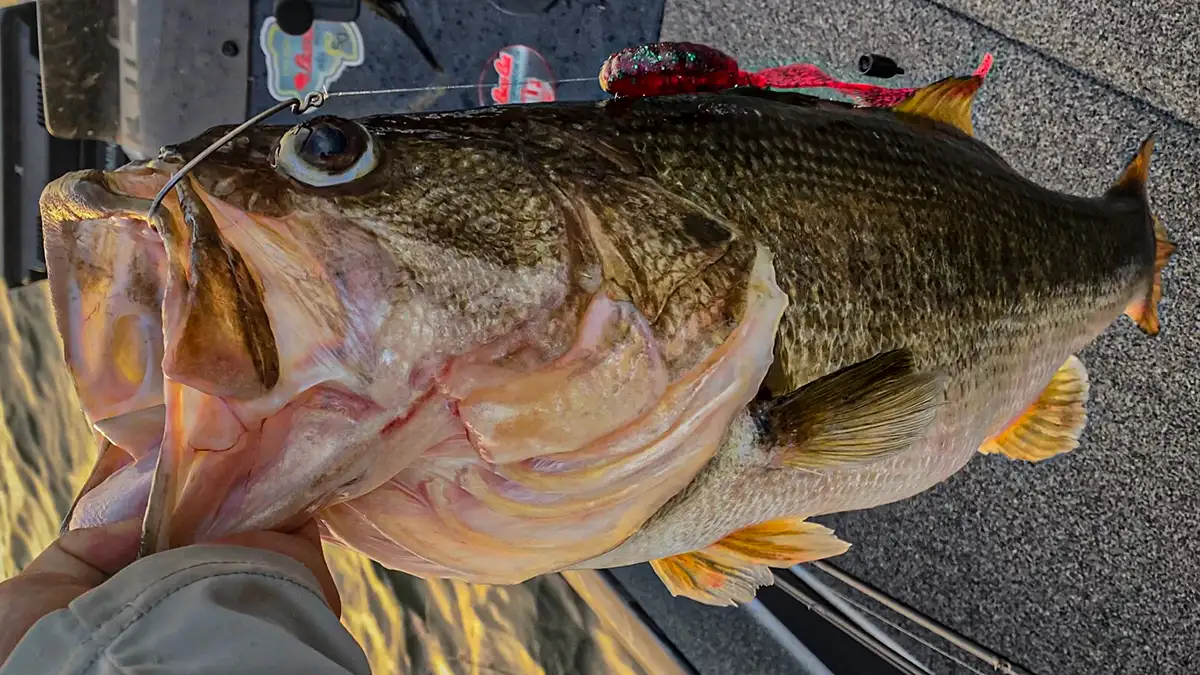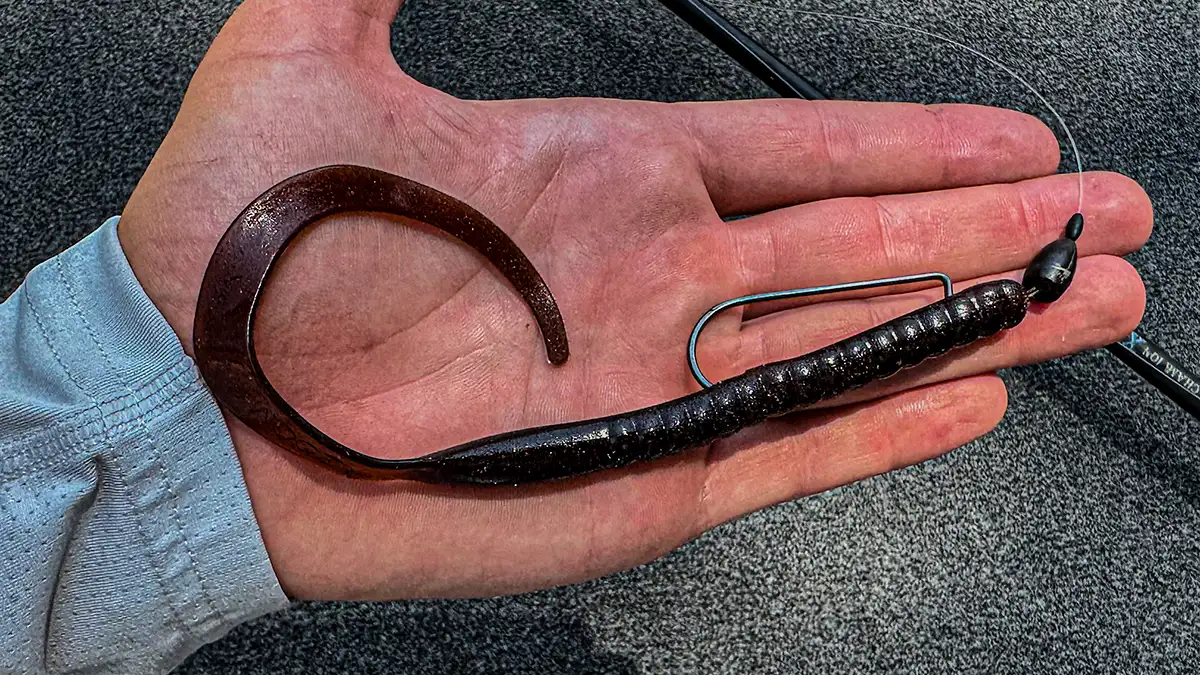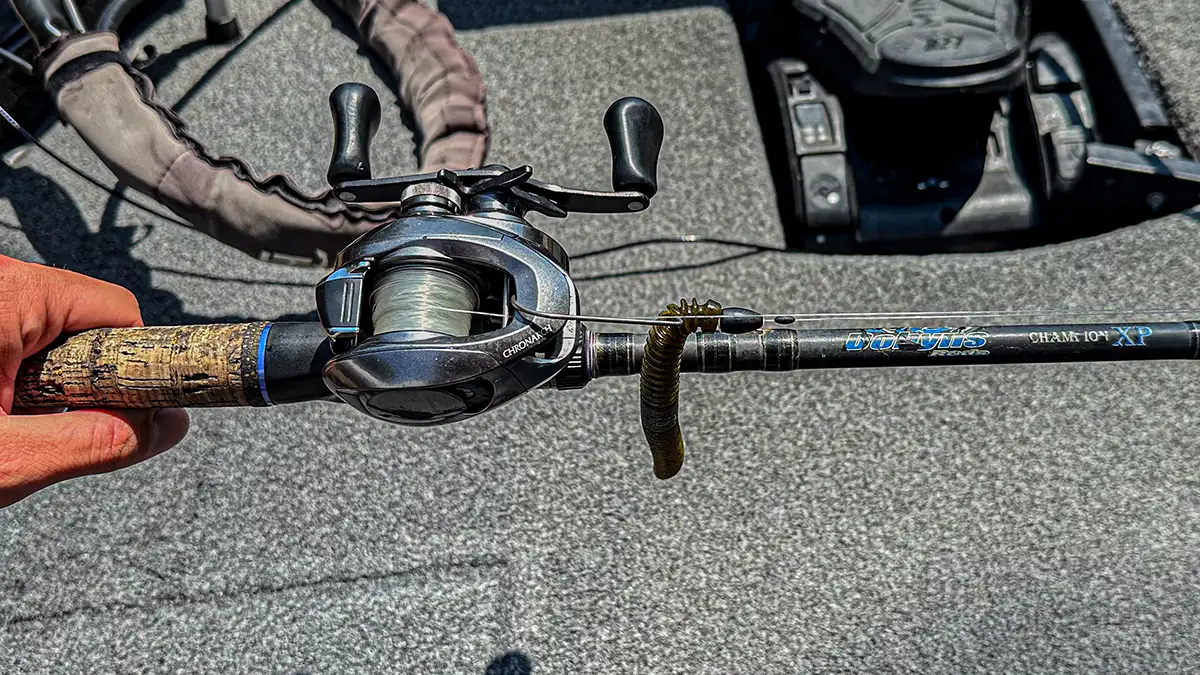Warning: Undefined variable $k in /home/nginx/domains/wired2fishcom.bigscoots-staging.com/public/wp-content/themes/understrap-child-0.6.0/functions.php on line 984
Warning: Undefined variable $k in /home/nginx/domains/wired2fishcom.bigscoots-staging.com/public/wp-content/themes/understrap-child-0.6.0/functions.php on line 987
Dragging a worm is an effective method for catching large bass across the country. Whether you’re using a Carolina rig for smallmouth on the St. Lawrence or a big shaky head on Lake Guntersville, a large worm can attract some of the lake’s biggest fish. Late summer is particularly ideal for this technique.
As water temperatures peak during late summer, bass become sluggish and move deeper in search of cooler, more comfortable conditions. This is the perfect opportunity to use ribbon tail worms and drag them around to entice these deeper fish.

WHY WE USE RUBBER WORMS
A plastic worm has been a top fish catcher since the sport of bass fishing began. Fish all over the country seem to react to this lure regardless of the conditions. It seems that no matter the day, you can always go out and catch a few fish on a worm. However, other fast moving baits may work extremely well one, day but not the next. This leads to the question, why do bass almost always eat a plastic worms?
A plastic worm resembles a wealth of forage types that fish all over the country feed on. Some of these include leeches, worms or smaller forage such as crawdads or smaller baitfish. However, the biggest reason fish commit to these types of baits is the presentation. Bass are extremely territorial and like to protect their personal space. Reaction baits such as jerkbaits move quickly through the water column and are great for generating bites when the fish are willing to chase, however they fall short when fish are glued to the bottom not wanting to feed. This is when the plastic worm shines.
Slowly dragging a worm through cover is a great way to coax a bass into biting when they aren’t willing to chase down a lure. Being a territorial fish, bass don’t like for forage to invade their personal space. Slowly dragging a a big worm through brush piles or other pieces of cover fish hold on will often aggravate them enough to eat the bait as a defense mechanism. This is a great way to target some of the bigger fish in the lake.
This is especially true when fishing around lots of smaller fish. By upgrading the size of your worm, it allows you to target the larger fish in the area and keep some of the smaller fish from eating it before the big ones get the chance. In lakes that have a big spotted bass and largemouth population, I really like to use a big worm. Spotted bass are often faster and way more prevalent than largemouth in these types of fisheries.
Throwing a big worm allows you to slow down and tease larger bass. This is a great way to single out bigger largemouth in lakes with a dominant spotted bass population. While understanding the reasoning behind throwing a worm is important, it is equally crucial to understand where to throw this style of bait.

WHERE TO FISH A WORM
Dragging a worm works great both shallow and deep, however during the late summer I prefer to target deeper offshore structure. This can be anything from brush piles to boulders depending on the body of water. Some of my favorite types of cover include, brushpiles, shell beds, and isolated rock.
When fishing spotted bass fisheries where largemouth tend to be more isolated as opposed to lake such as Guntersville, I target brush piles. Brush piles tend to hold a mix of both spotted and largemouth bass and are high percentage locations to get a bite. When the water is hot, I target brush piles in deep water and oftentimes related to the main creek or river channel. These brush piles hold the majority of fish in the summer and oftentimes the bigger fish in the area.
Once a brush pile has been located, sit about 60-80 feet away and make a few casts with a big ribbon tail worm such as a Zoom Ol’ Monster. Once I feel the worm make contact with the pile, I let it sit, moving the bait slightly every 15 seconds or so. After a few casts with a big worm, I then like to decrease the size and make a few more casts with a smaller bait such as a Strike King Filler Worm. This allows you to pick off a few fish that were too intimidated to eat the larger bait. I then like to rotate to another brushpile and repeat the process.
On largemouth lakes such as Guntersville, I like to target shell beds or other locations where largemouth group up. I maintain my distance from the structure with the goal of not disturbing the area. I then keep the same basic principle of starting with a big worm then changing to a smaller one after a few casts. This allows you to target some of the bigger fish in the area before switching up to a more finesse presentation.
Another type of cover I like to target with a worm is isolated rock. This is especially true on smallmouth fisheries whether it be on the TVA or up north on a fishery like the St. Lawrence River. In the late summer the fish have moved out deep holding on isolated rock with current rolling over it. These smallmouth tend to sit right behind the rock out of the current waiting for food to get pushed around the rocks, allowing them to shoot out and ambush the prey. A great way to approach this type of cover is by Spot Locking down current of your target and allowing your bait to drift over the rocks back to the boat.
I typically like to downsize my worm when fishing these types of fisheries because it allows these smallmouth to consume the bait much easier. I like to make repeated casts at the same rocks in order to give the fish a different presentation and multiple chances to strike. I also prefer to target deeper rock this time of year. Drifting a worm over rocks is a great way to catch some quality fish in hot weather.
HOW TO FISH A WORM
Fishing a worm is a super easy way for anyone to catch fish regardless of their skill level. However, there are a couple nuances that can help you be more efficient when employing this technique. Dragging a worm is all about patience. I’ve had way more success letting my worm sit compared to fishing it quickly along the bottom. Bass are extremely territorial. Allowing your bait to sit in front of their face for an extended amount of time will often trigger a strike due to their aggressive nature.
Another important attribute when fishing a worm is bottom contact. Bass typically hold on harder cover such as shell beds or brush piles. So feeling these types of cover with your worm is often crucial for generating bites. Using a tungsten weight is a great way to increase the sensitivity of your lure. This allows you to feel the bottom much better than with a typical lead weight. When dragging a worm, I drag it faster until I start to feel contact with either hard bottom or cover. I will then slow down and let my worm sit, allowing fish to key in on my baits presence. This allows you to keep your bait in the strike zone much longer as opposed to letting your bait sit in unproductive water.

IDEAL WORM SETUP
Understanding where and when to throw a worm is extremely important, however it doesn’t mean much if you don’t have the proper setup that allows you to land these bass. I typically rotate between a spinning and casting setup depending on the size of the worm I’m throwing. I like a heavier casting setup that allows me to yank bigger fish out of cover when throwing a larger sized worm. I also prefer a lighter spinning setup that allows for me to downsize line when throwing a smaller sized worm.
For my casting setup, I like a longer heavy action rod. It is also important to have a rod with a lot of sensitivity. This allows you to distinguish between making contact with brush and an actual bite. I also like a reel with a decent sized spool that allows you to throw slightly heavier line in order to winch fish out of heavy cover. I generally stick with either 15 to 17-pound line depending on the amount of cover present. My go to setup for this application is a 7-foot 4-inch heavy-action Dobyns Champion XP with a Shimano Chronarch 150 MGL in the 7:1 gear ratio.
For my spinning setup, I like a medium action rod with a decent sized reel. I still like a slightly heavier rod because it gives you a little more control over the fish when reeling them out of heavy cover. I also like a slightly larger reel because it allows you to hold more line and make longer casts than with a smaller sized spool. I like to use 15 pound braided line connected to a 10 to 12-pound fluorocarbon leader depending on the amount of cover present. My go to setup for this application is a 7-foot Medium Abu Garcia Zenon with a 3000 sized Daiwa Ballistic MQ LT spinning reel. The Daiwa Ballistic was also picked in our best spinning reels article.
Dragging a worm is a super productive way to catch fish year round, however, it really shines in the late summer months. This is a super easy way to go out and catch a ton of fish regardless of where you are in the country. This is also a great way to get someone into bass fishing who doesn’t have much experience throwing more complicated baits in deep water. If you are looking to catch quantity and quality bass this summer, dragging a worm is a great place to start.












